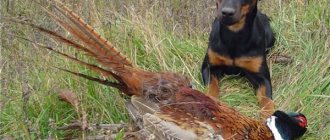Can I take my dog with me to the salon?
Airlines allow small dogs to be carried in the cabin of an airliner. Each passenger must first familiarize themselves with the conditions for transporting pets. They are different for different air carriers. True, there are a number of general requirements that all airlines, without exception, impose on the transportation of animals.
Certain breeds of animals are accepted into the salon. Their weight cannot exceed 5 or 8 kg. Animals must have a veterinary passport or veterinary certificate (Form No. 1). The main requirement is all vaccinations and excellent health.
The animal must be in a carrier. You must inform an airline employee about transporting an animal 36 hours before departure. An airline passenger with a dog will not be able to fly business class. He will have to keep the pet carrier on his lap or under the seat.
Rules for transporting dogs on an airplane
There are a number of main requirements that air passengers must fulfill in order to be allowed on an airliner with a pet. If you ignore them, you will have to cancel your flight and choose another mode of transport for your trip.
Sample veterinary certificate
Rules for transporting dogs on planes in 2021:
- You can take no more than five animals on board;
- pets of a certain breed can fly;
- animals are transported only in a container;
- presence of a muzzle and leash;
- up to 8 kg - in the cabin, more than 8 kg - in the cargo compartment;
- dangerous breeds of animals are transported only in the cargo compartment;
- a guide dog and a canine service dog are carried in the cabin;
- veterinary passport or veterinary certificate;
- the air carrier is warned about the desire to fly with an animal 36 or 72 hours before takeoff;
- To fly a pet, you need the carrier's permission;
- they don’t buy a ticket for the animal, it is checked in as non-standard luggage;
- Before departure, the animals are examined by an airport veterinarian.
In the cabin of the plane
It is allowed to carry two healthy adult animals or three puppies in the aircraft cabin at the same time. All pets must sit in the same carrier. The total weight of the animals with the container is up to 8 kg. In the carrier, the pet should behave quietly and calmly and feel quite comfortable. It is prohibited to hold a pet in your arms.
They transport small dogs on airplanes in a container on their laps or under someone else’s seat. Air passengers carrying pets cannot sit near emergency exits, in the first row of economy class, or near passengers with children or other animals. Be sure to have a veterinary kit in case your pet becomes ill.
The transported dog must sit in a carrier throughout the entire flight. He is not allowed to run between the rows. The dog must be accustomed to its crate, sit quietly, and there should be no odor coming from it.
36 or 48 hours before departure, you must ask the air carrier for permission to carry a pet in the cabin. There are restrictions on the simultaneous transportation of animals. When purchasing an air ticket, you can pay for services such as transporting an animal. You must take your veterinary passport or veterinary certificate with you on the flight. Upon arriving at the airport with your dog, you must undergo veterinary control. You need to get a separate boarding pass for your dog from the state veterinarian.
In the cargo compartment
Transporting a large breed dog has a number of features. Animals that weigh more than 8 kg, but less than 32 or 50 kg fly in the cargo compartment. Animals must be kept in good quality cages or spacious containers. A veterinary passport or veterinary certificate is issued for the pet. The air passenger notifies the air carrier in advance (36 hours) of his desire to transport the animal. It is advisable to arrive at the airport with your dog 3 hours before departure. You must undergo pre-flight veterinary control.
Animal flights are paid separately. Check-in of such non-standard baggage takes place at a special window at the airport. A document is drawn up for the container with the animal. A barcode is glued to the cell itself. It then enters the cargo area and is placed on a fixed pallet. Each container contains one animal. The cages themselves are durable and have secure locks.
The animal must stand on its paws and turn around in the cage. Be sure to give him a container of water. Transportation of adult dogs and puppies across Russia in the cargo compartment includes the following breeds: fighting, guard, aggressive and ordinary, whose weight is more than 8 kg. Dangerous animals can only fly in a heavy-duty cage.
Ways to transport dogs, cats and other pets
Pets are allowed in the cabin and cargo area. Each method has its own requirements, but in both options the animal must be kept only in a container or cage (this rule does not apply to guide dogs and service dogs, for example, assistant dog handlers).
Salon
Only domesticated pets (cats and dogs, certain types of birds, ferrets) are allowed in the cabin. Others, even small animals, are transported in the luggage compartment.
This is how the dog is transported into the luggage compartment
Dangerous types of dogs (fighting dogs, guard dogs) are not allowed into the salon. They are transported in the cargo compartment in a heavy-duty structure.
The carrier cannot exceed 125 cm. If it is soft, it is possible to increase the size by 10 cm. This is due to the fact that the container is placed under the front seat in front of the passenger. And these are the dimensions that allow you to do this.
The weight of the animal together with the container should not exceed 8 kg. It is important that the animal can straighten up, turn around, and lie down in the carrier. At the bottom of the container you need to lay moisture-absorbing diapers and sheets.
If the dog is aggressive or constantly barks, an additional muzzle will be required. Often, passengers with animals are placed in remote areas, for example, near the exit or toilet stall.
A guide dog is transported in the cabin free of charge. It does not require a container; a muzzle, leash and collar are enough. To confirm the need for a dog to accompany a passenger, you need a document indicating the person’s disability and a certificate confirming the animal’s training.
Dogs of cynological organizations are also transported in the cabin free of charge.
Transport in the luggage compartment
If the weight of the pet together with the container exceeds 8 kg, it is transported in luggage. The weight of the animal together with the cage should not exceed 50 kg. You must purchase the container yourself; airlines do not provide it. Ventilation mesh is required.
Requirements for containers for transporting animals on an airplane
An animal is allowed to be transported unaccompanied, but this means that it will only be in luggage. Documents will require a sender's certificate and a certificate from the veterinary clinic about the health of the pet. On international routes you will still need permission from the countries of export, import and transit.
Adviсe:
- Do not feed your pet sedatives. The exception is a doctor's order.
- It's better to fly non-stop.
- Ask to monitor the loading of the animal, if possible.
- Write down all the necessary contact information (for example, on the collar).
- Notify the flight attendant that the animal is in your luggage.
- It is better to trim your pet's claws first to ensure maximum safety during the flight.
- Introduce your pet to the container in advance to minimize discomfort.
- In winter, fly for days, in summer - in the evening or morning.
Most airline employees treat animals with care, but it's best if you also take care of your four-legged friend.
Choosing the right carrier
To transport your pet in the cabin or in the luggage compartment, you need to choose the right carrier. There are a number of requirements for containers in which pets will be kept during the flight. It is important to know how to choose the right carrier for your dog. After all, the animal’s comfort in flight depends on this.
The soft carrier is designed for transporting small animals in the cabin. The animal is placed in a bag or small plastic container and carried on board as ordinary hand luggage.
The size of a carrier for small dogs on an airplane is: 1 m 15 cm (the sum of three dimensions). The weight of the cage together with the animal itself is only up to 8 kg. The bottom is lined with material that quickly absorbs moisture and unpleasant odors. The portable cage bag must have a secure lock and handles. During the flight, the container rests on the lap or under the seat in front of the person sitting in front. It cannot be placed on the next seat or in the overhead compartment for hand luggage.
For large animals, dog containers are used to transport them. The requirements for them are: comfort, the ability to stand on their paws and turn around. The weight of the cage with the animal is from 8 to 32 (50) kg. A container for transporting large dogs must have the following dimensions: from 1 m 55 cm to 2 m 3 cm (the combined size of three sides).
All dog crates are made of durable plastic or metal and have holes at the top for ventilation. The door is metal. The bottom is waterproof. The carrier is locked with a secure lock. A quality certificate is required. The cargo compartment itself, in which animals fly, must be heated. It is usually located in the nose of the airliner under business class.
Have you ever transported a dog on a plane?
Not really
Who to fly with
First of all, study the information about transporting animals on the official website of the airline. Make sure that all the questions we list below are answered there, and then call to clarify:
- those moments that are not described;
- something that is not fully understood;
- Is all the information on the site current?
Before you buy a plane ticket, find out if the airline has restrictions on dogs of your breed (or your mixed breed). For example, some airlines allow dogs of fighting breeds to be transported only in the luggage compartment in carriers with a special design, while brachycephalic dogs with a short muzzle are often not allowed on board at all, or the rules are written in such a way that the flight becomes impossible.
Olga Mikhailova
Works in an IT company, travels with French bulldog Bagel since 2021
We only choose to travel by train or car - airplanes are potentially dangerous for dogs with flattened faces. A sudden change in pressure can affect the dog’s condition in different ways, so it is important to be with him in the salon, but the salon is only allowed with dogs that weigh up to 8 kilograms including the carrier, and rarely is a bulldog so small. Our Bublik is considered quite compact in his breed, but even he weighs 11.5 kg. Of course, there is no question of checking the dog in as luggage. Too dangerous.
- Find out how much a dog can weigh with a carrier in order to fly in the cabin, and how much in the luggage compartment. In general, 8 kg including carrying is the norm for flying in the cabin of most airlines. But the luggage compartment, unfortunately, is also not unlimited, and the maximum limit here for boxing with a dog is usually about 50 kg. So the Caucasian Shepherd and her oversized friends will have to travel by plane like cargo - all the nuances about transportation as cargo need to be discussed privately; This story is more complicated, and usually such large dogs are transported not for the sake of travel, but because of relocation.
- Find out what the requirements for carrying dimensions are. If the dog inside stands at full height and turns 360 degrees without a yoga course, this is the first step to success. For the rest, you need to look at a specific carrier: someone indicates the height, someone - the amount of measurements. Everyone has their own exact data.
- When you understand exactly how your animal will fly - in the cabin or with luggage - ask to calculate the cost of transportation.
- And the last thing: before buying a ticket, when you have already decided which flight to fly, call the air carrier again and find out whether the quota for the number of animals on board has been exceeded and, if the dog is flying in the luggage compartment, whether this compartment is heated - a dog cannot fly in an unheated one . If everything is ok with this, all that remains is to clarify the operating hours of the veterinary control at the airport (most often around the clock), pre-book a place for the dog and, having purchased a ticket, receive confirmation of the reservation for it.
Marusya Archuk
Creative producer, traveling with Yorkshire terrier Ponyo since 2012
We fly to Istanbul all the time. We tried Aeroflot, Turkish Airlines and Pegasus. We settled on the latter, based on the cost of tickets and payment for the dog in the cabin. With Pegasus it’s about 25–30 euros, while Turkish Airlines and Aeroflot are now asking about 70. And conveniently, with Pegasus you can pay for the transportation of the animal in advance by calling.
Pegasus flight attendants usually calmly allow you to open the carrier, pick up the dog, and feed it. Aeroflot has two types of teams: some cooze with the animals and bring water, others strictly prohibit even opening the carrier. We always behave according to the situation.
Alena Martynenko
The manager of the Little Bakery project has been traveling with the corgi mix Dickens since 2021
I monitored different airlines for a long time, and the longer, the more I shrugged: only three of the six carry the same dimensions as the one with which I can get into the cabin. At the same time, none of the dimensions of the carriers coincide with the requirements of the airlines.
Carrying + the weight of the dog is 50% of the success of the flight. The remaining 50% is check-in for the flight. The main problem: there are airlines whose rules state that the height of a container should not exceed 20 cm - it’s not very clear what it should look like. In the end, we chose Aeroflot. There, it is the sum of the three dimensions (135 cm) that is important, and not the height of the container.
Adviсe
- Those whose weight of the dog with the carrier is only slightly exceeded can try their luck already on the spot, at the airport.
- Please note that if a dog flies like cargo, cargo takes much longer to unload than regular luggage; do not forget to allow this time as much as possible for the flight. You will probably need to take a ticket not to the final destination, but to the city, from where you can get there by car or public transport.
- When the carrier greatly increases the overall weight and makes it difficult to squeeze into the required dimensions, you can try to break this point - for example, use a cat carrier-bag without walls and other options that fit into the formal requirements. Experienced travelers with dogs recommend the Sherpa carrier.
- If you fly with a low-cost airline, there will most likely be departure delays - this can be dangerous for the dog, which will have to wait away from you among someone else's luggage for an unknown amount of time.
- Dogs that fly in the luggage compartment should not be carried on connecting flights.
- If your dog is flying in the cabin and with transfers, plan to go outside and take a walk during the break.
- It is best to receive official confirmation that the dog is registered for the flight by letter - it can be useful if there are questions at the airport.
Who should not be transported?
According to the rules for transporting animals on an airplane, the following are not accepted on board:
- brachycephalic breeds (pug, Pekingese, bulldog, boxer);
- sick or experimental animals;
- dogs that are too large (50 kg);
- pregnant animals;
- small puppies (up to 3 months);
- pets over 10 years old who have chronic diseases.
An air passenger may be refused permission to fly a pet if there is no quota for the animal on a particular flight. One reason for failure may be the inability to maintain the proper temperature in the cargo compartment. A citizen with a dog may not be allowed on the flight if the breed does not correspond to that previously specified in the document, or the owner does not have all the certificates for the flight of his pet. If an animal demonstrates restless or aggressive behavior, it will not be allowed on board, even in a container.
Exceptions to the rules - guide dogs and service animals
A guide dog or service animal is permitted in the aircraft cabin. This category of animals is allowed on board regardless of their weight or breed. True, they must have muzzles and short leashes. Owners and their pets enter the salon first. The animal is tied to a seat in flight. It should not sit in the aisle and disturb other air passengers.
A guide dog that accompanies a visually impaired person flies free of charge. The air passenger must have a disability certificate and the entire package of documents for his guide. The dog must undergo special training. The animal can also accompany a disabled minor who is over 12 years old.
A canine service dog flying with a federal employee is allowed in the cabin, but its transportation must be paid for. The cost of transportation corresponds to a special tariff. A person flying with a service dog must have a certificate confirming his status. The animal must have a document confirming that it has undergone special training.
Airline requirements for transporting dogs
Airlines usually do not post precise information about the transportation of a certain type of animal on their personal websites, or only describe brief information in general terms. Therefore, it is difficult to understand whether transportation of a particular animal is allowed, how much this service costs, what needs to be done to prepare for the flight, what vaccinations to get. Therefore, immediately after deciding to go on a trip or move to a new place with an animal, you should call the chosen airline and ask about the requirements for transporting dogs by plane in Russia and to other countries.
Only small breeds are transported in the cabin
A certain number of animals are allowed on board. For example, most airlines only allow up to five pets in the cabin. The rest will most likely have to place the animal in the baggage section or take a different flight. That is why it is advisable to contact the airline as soon as possible to book and purchase a ticket if you need to bring your dog in the cabin. It is necessary to indicate that a pet will travel with the passenger.
It is advisable to book a ticket in advance and inform about the flight with your pet. In the case where the ticket is planned to be purchased directly at the airport of departure, there is a high risk of being denied the trip. Therefore, it is required to notify the airline about the animal at least 1.5 days before the expected departure. Transportation of pets must be carried out by a person over 18 years of age and fully capable. The owner bears full responsibility for the life and health of the pet. If something happens, a person must be able to calm the pet or provide first aid.
Confirmation for animal transportation
Requirements for animals:
- The pet must not behave aggressively towards employees and passengers.
- Animals that are too large or heavy, such as a dog weighing more than 50 kg, are not allowed.
- The animal should not be too distracting to other passengers in the cabin (barking incessantly, etc.).
- The animal must be in a cage or carrier bag.
- A veterinary passport is required, which describes the breed, distinctive features, vaccination notes and good health of the dog.
- Animals are transported only in the presence of an accompanying passenger.
Miniature and light dogs are allowed to fly with a person in the cabin. Typically, individuals weighing 2–6 kg are allowed, but the maximum weight is up to 8 kg. All other animals must be transported in the luggage compartment in a specialized cage.
The guide has the right to be in the cabin
It is important to know specific cases when pets are not allowed to fly or all restrictions are lifted from them:
| Breed or group of dogs | Status (allowed or not to fly) | Description |
| Animals that the canine service worked with, and now they are service dogs | They are allowed to fly; dogs are not subject to weight restrictions (if they are heavier than 50 kg, they are still allowed on board and even in the passenger cabin). There are also no breed restrictions | Animals that perform search or security tasks do not have the right not to be allowed on board. But at least one federal employee must be with him and there must be confirmation of the dog’s professional suitability |
| Guide dog (guide) | Allowed to fly without restrictions on breed and weight. The airline must allow dogs to fly in the cabin. | A guide dog that plays the role of protection and assistance for people with health problems (partial or complete blindness) should not be separated from its owner; this is prohibited by law. Such dogs are transported absolutely free of charge. |
| Brachycephalic breeds | Most airlines do not allow travel | The ban is due to the animal's poor health and the likelihood of injury or death during the flight. |
| Breeds that pose a potential danger to passengers and workers | Dangerous breeds are placed in separate, more reinforced and isolated cages so that the dog does not harm other people and pets | These breeds include guard and fighting dogs, especially large ones |
| Puppies | In principle, there are no strict restrictions on the transportation of puppies, and it is allowed at any age | Although there is no ban on transporting small puppies, the only requirement for the flight is a veterinary passport with a note on all vaccinations. And the first vaccination is given to puppies no earlier than 8 weeks. And from the time of vaccination until the flight on an airplane, at least 30 days must pass in order to see possible side effects and the reaction of the puppy’s body to vaccinations. So, in fact, puppies will not be allowed on board the plane before 3 months. |
| Pregnant bitches | Allowed, but only with veterinarian permission | If the bitch is in early pregnancy, then the flight will take place without problems. But if labor is likely to begin soon, the animal is allowed on board only after written permission from the veterinarian |
| Outbred | Allowed | Almost everywhere information is provided for purebred dogs, but many do not know whether there are special features for transporting mongrel dogs. To obtain permission to travel, you must contact the nearest club of the Federation of Amateur Dog Breeding. It describes the color, size, weight, and name of the animal. Then you need to buy a veterinary passport and undergo an examination by a veterinarian, who will fill in the necessary fields |
Necessary documents for transporting an animal
What documents are required for a pet to fly:
- veterinary passport for flights within Russia;
- veterinary certificate (form No. 1) when traveling abroad.
It is recommended that the animal be vaccinated against rabies 30 days before departure. It is valid for one year. The veterinary passport contains the breed, name, weight, age, information about the owner, information about vaccinations. The veterinary certificate is issued on the basis of the veterinary passport. It also contains all the information about vaccinations. The certificate is issued by the veterinary service, and it confirms that the pet has no dangerous diseases. However, such a document is valid only for 5 days from the date of issue.
Each animal undergoes veterinary control at the airport. It lasts 40 minutes. You can go through veterinary control a day before departure and receive a document for transporting your pet (boarding pass). The veterinary control officer puts a stamp on the animal’s veterinary passport.
Do I need to buy a ticket?
You don't need to buy a plane ticket for your dog. It flies like non-standard luggage. There is an additional charge for transporting the animal in the luggage compartment or as hand luggage. The cost of the service is added to the total price of the air ticket.
What documents are needed
What does an F1 veterinary certificate look like?
For a flight within Russia:
| Document | Description |
| Veterinary passport | Mandatory document proving the identity of the animal. The dog's passport with a vaccination note describes the breed, color, name, weight, age, information about the owner (first name, surname, patronymic, residential address, number), information about vaccination and vaccinations. |
| Veterinary certificate in form No. 1 (veterinary certificate F1) | Without this document, you will also not be allowed on board the plane. After all, it contains complete information about the absence of dangerous diseases, ailments, and abnormalities in the animal. It also contains information about the owner, flight route, information about the pet (name, gender, breed, age, weight), information about vaccinations performed and the results of tests for various diseases. To obtain this certificate for departure, you need to contact a veterinary clinic. |
Mandatory veterinary passport
Attention! The veterinary certificate in Form No. 1 is valid only for five days. You should go for it a day or two before the flight; you should not take it in advance.
After checking these two documents during registration, the pet must undergo an additional veterinary examination. It usually lasts half an hour. Some advise to undergo veterinary control in advance, several hours or even a day before the flight.
How is the veterinary passport filled out?
To fly abroad with a dog:
| Document | Description |
| International veterinary passport | To fly abroad you will need a higher quality veterinary passport. First, you need to obtain a state-issued veterinary certificate for your pet in your country. Then only it is changed to an international veterinary passport. But its validity is limited - it is valid for only 90 days. After a one-way flight, you cannot throw it away or lose it - you will still need it for your return, even if the tickets were purchased in advance. The international veterinary passport contains complete information about the pet, the owner, as well as a complete list of vaccinations |
| Chipping | Chipping is the insertion of a small capsule with a microchip under the skin of an animal. Although many people consider this procedure cruel and oppose it, microchipping is not very painful for the animal. But if you lose an animal, you can easily find it; to do this, just scan a chip with an individual number and find out all the information about the dog and its owner. The procedure is mandatory for flying to most developed foreign countries |
You will also need documents and a plane ticket for the owner and accompanying dog.
International veterinary passport
What vaccinations do you need to get?
Vaccination sheet
| Vaccination or pills | Description |
| Rabies vaccination | Mandatory for transporting animals in Russia and abroad. Made for puppies over 2 months old |
| Tablets against helminths | If the veterinarian discovers helminths or worms, then you need to take a course of anthelmintic drugs |
| Treatment for trichophytosis and microsporia | Microsporia, or ringworm, is transmitted to other animals and people, so it must be treated before planning a flight |
Attention! All vaccinations must be completed at least 30 days before departure. Failure to comply with this rule may result in your pet simply being denied the flight. A veterinary certificate, and especially an international veterinary passport, is issued only 30 days after vaccination. Therefore, if the animal does not have the necessary vaccinations, then they must be given at least 2 months before the flight, and better yet even earlier.
How to prepare your dog for a flight and what to take with you?
It is recommended to prepare your dog for the flight in advance. To do this, she is not fed 2–4 hours before departure. All dogs are allowed on the plane only in cages. It is necessary to purchase such a container in advance and train your pet to stay in it for a long time.
You can transport your dog if you first undergo veterinary control. This means that you need to arrive at the airport 2–3 hours before departure. Before entering the airport terminal, you need to walk your pet.
You can only take a veterinary kit and water on board the plane. It is not recommended to feed the animal during the flight. Be sure to have plastic bags and wet wipes with you.
Dog owners want their pets to sleep during the flight. However, giving sleeping pills to animals is not recommended. It lowers blood pressure, and the dog can die in flight.
Features of flights abroad
If your pet is traveling abroad with its owner on a plane, you must first learn the rules for transporting the animal. Each country and airline company sets its own restrictions. There are states that do not allow the import of any dogs. Some prohibit the import of only fighting breeds. Your pet will also need additional vaccinations. Upon arrival in some foreign countries, the animal will be asked to be quarantined. It can last 14 days or several months. While the dog is being checked, the owner is forced to pay for its maintenance.
Requirements for transporting a pet abroad:
- international veterinary certificate;
- the breed is not breeding, not valuable (otherwise you need additional permission from the canine service);
- the pet is microchipped;
- the blood has been checked and there are rabies vaccinations;
- sticker with information in English.
Veterinary certificate of international standard
An international veterinary certificate is issued on the basis of a veterinary certificate in Form No. 1, which is valid for only 5 days. At the pre-vet control point, dog owners receive an international sample document for their pet’s flight. However, it is valid only for 90 days. The international certificate must be kept throughout the entire trip. With it, the animal will be able to leave a foreign country.
Cost of transporting dogs in various airlines
The flight of the animal must be paid additionally. It is processed as non-standard luggage. An airline passenger pays for a pet, even when not carrying carry-on or checked baggage. The transportation of each dog is paid separately.
The transportation of any animal must be agreed upon with the airline staff in advance (72–36 hours in advance). Before booking a flight, you must obtain permission to fly your pet. Payment for transportation can be fixed or depend on the weight of the pet.
How much does it cost to transport a pet from different air carriers (in rubles):
- Aeroflot: for international - 5,440, for domestic - 3,750.
- S7: abroad - 5,000, within Russia - 2,500.
- Ural Airlines: for international - 4,300, for domestic - 2,500.
Pets are rarely allowed on charter flights. If an air carrier agrees to fly a dog on board an airliner, the cost of such a service may be 100 or 200 euros.
How to transport a dog unaccompanied?
Some air carriers allow dogs to be carried alone, that is, by plane, but without being accompanied by the owner. The service is paid according to current tariffs. To carry out such a flight with a dog, you must issue a power of attorney to an airline employee and draw up an accompanying document.
An airline employee will monitor the animal during the flight. The owner is obliged to arrive at the airport 2 hours before departure and bring all the documents necessary for transporting the pet. The animal must be in a cage. The owner must wait for the plane to take off. After landing at the final destination, the animal must be picked up by the person whose details are indicated on the accompanying sheet.
What to do on the day of departure
- Calculate the time so that you arrive at the airport in advance (at least half an hour earlier than usual) and at the same time put your dog, tired from a good walk, on the plane. A tired dog can handle a flight easier.
- Do not feed your dog on the day of departure. If you get motion sickness, this is additional stress for the dog.
- At the airport, first of all, go to the veterinary control desk, go through all the procedures that are asked, and last of all, hand over your dog if he is flying with luggage.
- You can usually walk around the airport safely with your dog before boarding; as part of the security check, you may be asked to pick it up and hand over the carrier to the security belt. When flying from different countries, there are some nuances: the French may ask you to hand over the collar and leash to the tape, while the Spaniards may ask you to put the dog in a carrier right on the tape after the scanner.
- Upon arrival, you may or may not be asked for documents for the dog. This is how it will go.
- It happens that if a dog flies in the luggage compartment, you can ask the staff to check it and add water. But it is not exactly.
- There can be very different attitudes towards dogs on board - just like on earth, dogs are treated differently in the sky; and just like on earth, in the sky you simply fly away with them.










